Odds & Ends: Adventures in the Forgotten Realms, Part 2
Last week, I started answering your questions about Dungeons & Dragons: Adventures in the Forgotten Realms. I had a lot of good questions, so I'm going to continue answering them today.
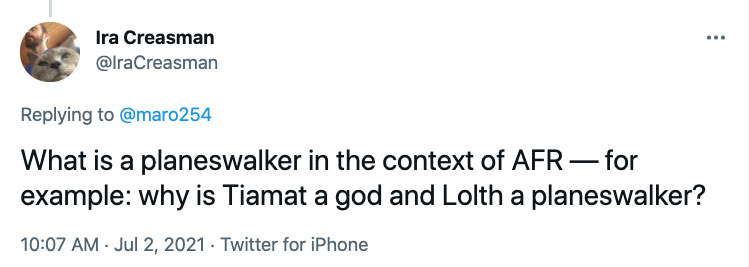
When we decided to first make a Magic set with another property, there was a lot of discussion about what a planeswalker card should mean. Planeswalkers have a clear definition within the world of Magic, but it's not something that most other properties have (although Dungeons & Dragons does have different worlds and characters that can travel between them—albeit not quite planeswalking in Magic terms).
First, we asked ourselves if sets themed after other properties should even have planeswalker cards. We decided they should. The planeswalker card type has become an integral part of the game, and these sets would feel much less like Magic sets if we didn't include the planeswalker card type.
Next, we asked ourselves if we should call them something different, a more generic term like champion. The idea being that champion (or whatever word we chose—champion is a keyword) would act as a parallel word, meaning that anything that interacted with planeswalkers would interact with champions and vice versa. We decided against this path; it would create a barrier between Magic sets that took place in the Magic Multiverse and sets that didn't. It would also add some unnecessary complication. We decided game terminology should stay the same even if it didn't make perfect sense in the property. Sorceries would be sorceries, for example, even though the term didn't match the world.
In the end, we decided to use the word "planeswalker" as a game term but not have it denote anything creatively. These cards were "planeswalkers" in how they played, but not definitionally in what it meant about them as characters. That said, the Adventures in the Forgotten Realms design team took several factors into account when choosing who the planeswalkers were going to be:
- Because planeswalkers had a sense of grandness, the team leaned toward "big name" characters, that is, characters that were much beloved by the D&D audience.
- Because planeswalkers have a sense of power, they leaned toward characters that were more powerful in the world.
- Because planeswalkers had a sense of travel, they considered characters that were known to travel between D&D worlds. (I should stress again that planeswalking and traveling between planes in D&D are not quite the same.)
- It was decided early on that the planeswalkers were going to be a monocolor cycle, so they leaned toward characters that felt appropriate as monocolor characters. That's why, for example, Tiamat couldn't be a planeswalker, as the card really wanted to be five colors.
- Finally, diversity is important to us, so we wanted to make sure the planeswalker cycle represented a diverse cast of characters.
I hope that helps explain the factors that went into choosing our planeswalkers for Adventures in the Forgotten Realms.
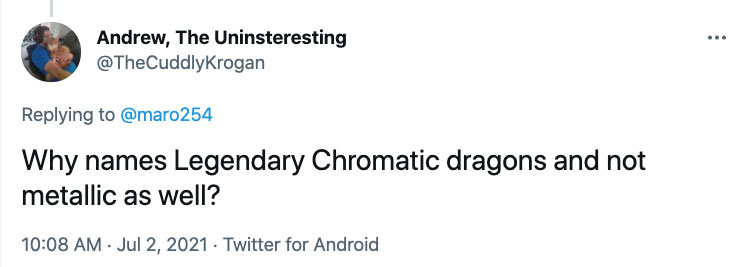
I'm going to answer all the "Why didn't you include [thing from D&D I personally love]" questions at once. D&D first came out in 1974. It's a roleplaying game, so there's a big desire for content. There are endless source books, novels, and articles with details about the various worlds and characters and magic spells and creatures and objects and so on. There's no way one set could possibly capture the entirety of 47 years of content. We tried hard to hit as many fan-favorite things as we could, but no matter what we did, the set was only going to have so many cards. A lot of things just weren't going to fit.
The good news is the set seems to be doing well, and as I said last week, that makes me optimistic that one day we'll do another D&D Magic product, so having things players want that we weren't able to do in this set isn't such a horrible thing.
Now, let me talk about the chromatic dragons specifically. D&D has a cycle of five kinds of dragons associated with colors that just happen to be the five Magic colors. One of the challenges in adapting another property to Magic is that things don't always fit neatly in how we do things, so when something lines up exactly, it's hard to avoid using it.
As I said above, there's a lot of things players want to see in a D&D set, so we tried to mix up what we're putting on cards. Once the chromatic dragons filled up space, it made it harder to make legendary metallic dragons, as the set had a bunch of Dragons in it already. It was nothing against the metallic dragons, they just weren't quite as good a fit as the chromatic ones. If we make another D&D Magic product in the future, I'm sure the metallic dragons will get a second look.
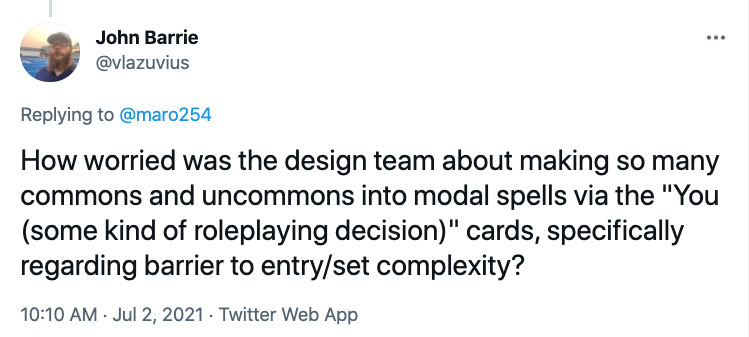
Not that worried. Testing over the years has shown modal cards aren't all that intimidating to newer players. Let me walk through why.
There are three types of complexity: comprehension complexity, board complexity, and strategic complexity. Comprehension complexity is about how hard a card is to read and understand. Modular cards aren't that hard to process. Do thing A or thing B. Modular cards usually don't cause comprehension complexity, especially when you have two simple effects.
Board complexity is about how hard it is to track a card when it's on the battlefield, monitoring both what it can do and how it interacts with every other permanent on the battlefield. Most modular cards are spells, and the few that are creatures usually have the modal component tied to an "enters the battlefield" effect. That means they either aren't on the battlefield or are virtual vanilla or virtual French vanilla creatures ("virtual" means looking at the card after its first turn). Modular cards, at least how we used them in Adventures in the Forgotten Realms, usually don't cause board complexity.
Strategic complexity is about understanding the impact the card is going to have on the game as a whole. This is where modular cards can start getting complex. Is it better to do thing A or thing B strategically? Interestingly, beginners don't yet have enough knowledge to be affected strongly by strategic complexity. They're not thinking turns ahead, so if they can use a card, they'll use it, and don't often sweat about what else it might do in the future. This means that modular cards usually don't cause strategic complexity for beginners. (For a more in-depth look into this topic, read my article here.)
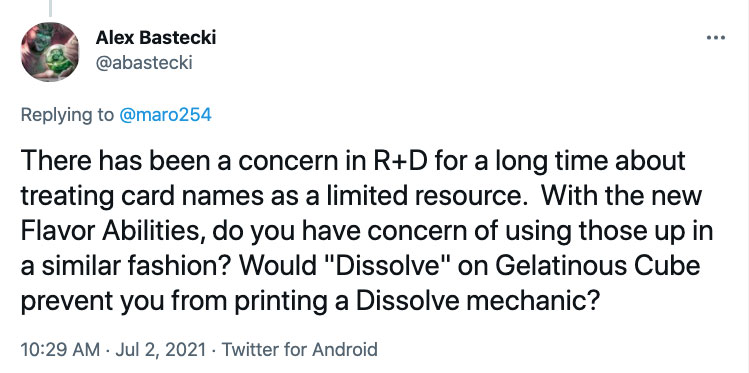
Something being a flavor word doesn't prevent us from later using it as a card name or mechanic name. There will probably be a little bit of a buffer (my guess is at least a few years) where we wouldn't use it, but after that, I believe the flavor text phrases will be fair game as card or mechanic names.
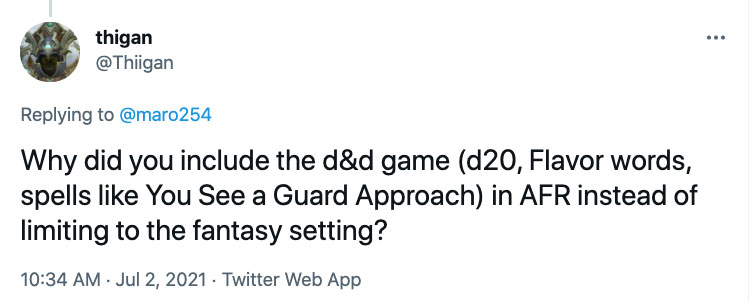
I'll give you the short answer and the longer answer. The short answer is we thought it would make for a more enjoyable set.
The longer answer is that we wanted to capture the essence of Dungeons & Dragons. We wanted playing Adventures in the Forgotten Realms to evoke a sense of playing D&D. Yes, the flavor is a good jumping-off point. Having the names, art, and flavor text all reference D&D lore helped evoke the feeling we were trying to create, but it only got us so far.
A lot of the essence that people associate with D&D is the act of playing it. For example, when you tell stories about your D&D session, yes, the flavor comes up, but also how you interacted with the game. Rolling dice, making in-story decisions, leveling up your character—those are all an iconic part of what makes Dungeons & Dragons D&D. If we're going to tap into the resonance of the D&D experience, those were just as important as the flavor, so we decided to capture both.
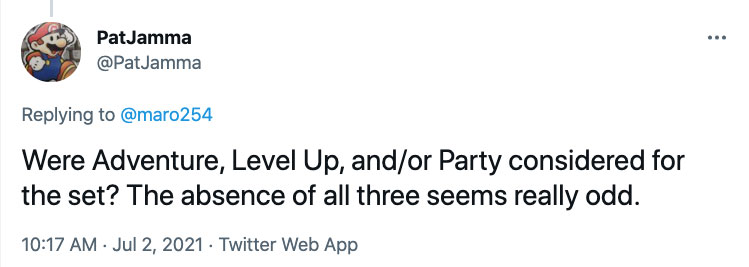
The design team considered all three mechanics. Both adventure and party were already in previous sets in Standard. Adventure competed with the venture into the dungeon mechanic, as they represented similar flavor space, and party requires a pretty substantial commitment to certain creature types that would have lessened the ability to do a lot of cool one-ofs, so the design team ended up passing on both.
Their exploration into bringing back level up evolved into the Class enchantments. I know it's very easy to look at past mechanics that fit well flavorfully and assume that they'd be slam-dunk inclusions in the set, but each mechanic comes with mechanical baggage that often doesn't mesh with what else is going on.
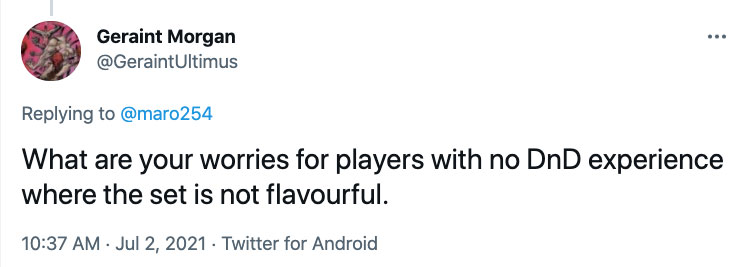
Let's imagine that there was zero overlap between Magic players and Dungeons & Dragons players. If we told Magic players we were going to a new plane called The Forgotten Realms and just used the creative from D&D, but didn't call it Dungeons & Dragons, I don't think anyone would even blink. It would just feel like this cool new world with some creatures and characters the players hadn't seen before, you know, like every plane we visit. Players would just accept it as a new Magic world.
What that means is, this stuff is cool even if you've never seen it before. It's fun and exciting even without context, and it matches well with Magic's aesthetic. So, no we weren't worried, because we knew Adventures in the Forgotten Realms would appeal to fans of fantasy, which is basically our audience, as we're a core fantasy game.
The one area where things might feel different is that we pushed into some mechanical space with a top-down fit for D&D—dungeons, classes, die rolling, etc. Again, those things are fun in a vacuum. You don't have to recognize the dungeons to mechanically enjoy them. You don't have to be able to identify the classes to enjoy enchantments that level up. Maybe you've never seen a twenty-sided die before (and you've probably seen a spindown if you're a Magic player, which is pretty close), but you can still enjoy rolling it to see what happens.
All in all, we weren't very worried, because we knew Adventures in the Forgotten Realms would play like a fun Magic set. Knowing D&D further enhances that experience, but it's not required.
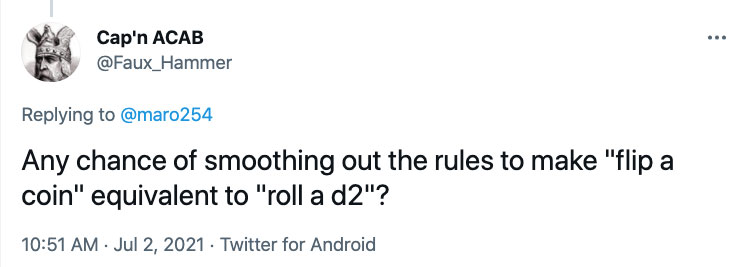
I love it when questions turn to philosophy. Is a coin a two-sided die? Gamers have argued this question for years. I'm in the "no" camp. At least, the "a coin isn't a die" camp. For example, there are three states a coin can land on (side one, side two, and on its edge, and yes the three are not of equal possibility), so it's not technically two-sided, and I feel a key component of being a die is that it can be rolled. It is possible to create a two-sided die (i.e., a die that's rollable and only has two outcomes), but that isn't something the average player would have easy access to.
Also, we make cards that interact with dice rolling, such as Krark's Other Thumb, and reducing the variance of the roll (1 out of 2 rather than 1 out of 6 or 1 out of 20) would probably break those cards. So, no, I don't believe there's a good chance of that happening.
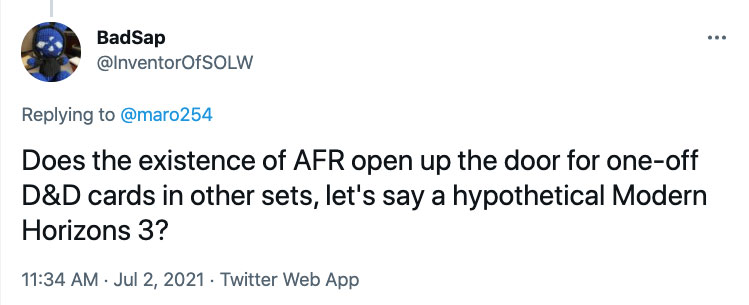
We've dipped our toe into this in the past with things like Bag of Holding, but now that Magic D&D products are a thing, my best guess is that we'll save them for those. It is possible, if it looks like we won't make any more, that we'd reconsider this, but since I'm optimistic about more Magic D&D products, I'll say I'm skeptical we'll throw one-off D&D cards into a non-D&D Magic set. Of course, as I say a lot on my blog, never say never.
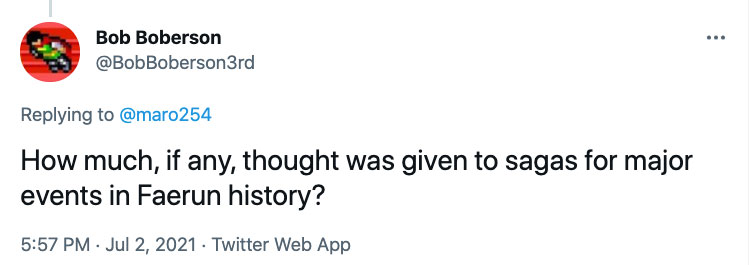
There are certain things that every set considers using—Sagas, double-faced cards, a bonus sheet, new external components, etc. Most of these things can work in any set, but we don't want to use them in every set. This is for numerous reasons. One, we want them to be exciting when we use them, so we want to be careful not to wear out their welcome. Two, there are logistical issues that accompany them, and while a set can handle one or two, they can't handle all of them. Three, each adds some complexity, and using too many would make the set harder to play.
So, yes, Sagas were considered, and we absolutely could have made very flavorful Sagas, but there were other things the design team chose to do instead because it was decided (by R&D at large, not just this design team) that other sets, such as Kaldheim, had more of a need for them.
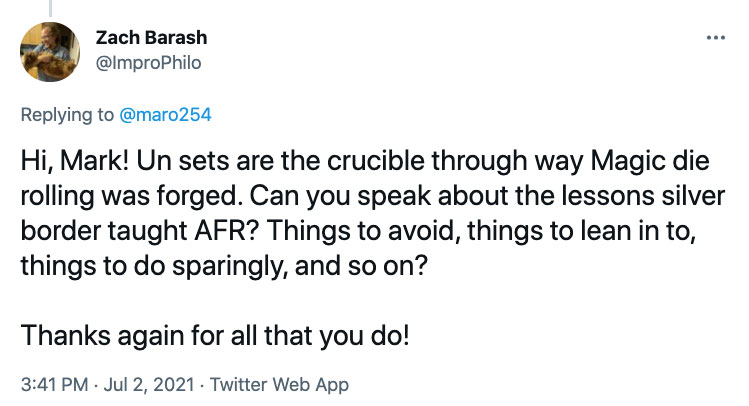
Here's my story (well, a short version of it) of what Un- sets have taught me about die rolling.
Unglued introduced die rolling to Magic. When we got the market research back on the set, several die-rolling cards were on the list of the cards players disliked most. So, when I was making Unhinged, I didn't use die rolling. I then got a lot of players complaining to me because they really liked die-rolling cards and were sad to see them missing. This caused me to go back and look at the original Unglued market research. It turns out that some of the die-rolling cards were disliked, but others were actually pretty popular.
What made players like some and not others? I looked at all the die-rolling cards and found the pattern.
The ones they didn't like were chaotic. You had no idea what was going happen when you played them. You couldn't plan around them. They also tended to have some outcomes that were negative, so not only was it unpredictable, but sometimes it actively hurt you. That just wasn't fun.
The ones they enjoyed were more predictable. You might not know how big Elvish Impersonators was going to get, but you knew that your die roll was always going to result in a creature. These cards also had only positive outcomes. They weren't going to hurt you for playing them.
The key lesson for me was that if used properly in a way that enhanced the fun of the uncertainty with the die and lessened the worry, die-rolling cards were a lot of fun for many players.
Adventures in the Forgotten Realms took that to heart. For example, die-rolling cards mostly do one thing. The die rolling might scale how good it is, but you can rely on at least getting a base amount of your effect. Second, you want your die-rolling cards to be net gain for the people who chose to play them. A little downside can be worked in when its flavorful, but you need to be careful that the die-rolling card is net upside.
"No More Questions, Please"
That's all the time I have for today. As always, I'm eager to get any feedback on today's column, on any of the answers I gave, or on Adventures in the Forgotten Realms as a whole. You can email me or contact me through any of my social media accounts (Twitter, Tumblr, Instagram, and TikTok).
Join me next week for this year's State of Design article.
Until then, may you play Adventures in the Forgotten Realms and generate more questions (which you can ask me at any time on Blogatog—my blog).
#857: AFR with Jules Robins
#857: AFR with Jules Robins
32:14
I sit down with Designer Jules Robins to talk about the design of Adventures in the Forgotten Realms.
#858: Vanity Cards
#858: Vanity Cards
29:54
In this podcast, I talk about what a vanity card is and walk through all the ones, that I could remember, in Magic.
- Episode 856 Parasitism
- Episode 855 Ice Age with Chris Page
- Episode 854 Creature Tokens, Part 2

